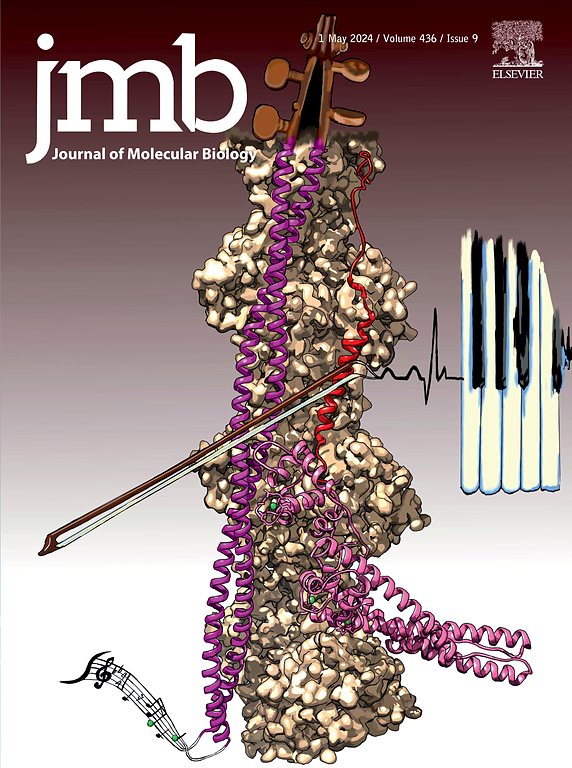Heligeom: A web resource to generate, analyze, and visualize filament architectures based on pairwise association geometries of biological macromolecules
IF 4.7
2区 生物学
Q1 BIOCHEMISTRY & MOLECULAR BIOLOGY
引用次数: 0
Abstract
At the subcellular level, macromolecules self-assemble to form molecular machinery in which the assembly modes play critical roles: the structural integrity of cell walls that allows mechanical growth, the maintenance and repair of the genetic material, membrane flow control, protein chaperoning, and ATP production, to cite just a few examples. As molecular modeling expands its scope to such systems, structural biologists are faced with the difficulty of understanding the structure and dynamics of these supramolecular assemblies. We present Heligeom, a webserver that offers a simple and efficient means for analyzing and constructing oligomeric assemblies based on user-provided structures of two interacting units. The input 3D coordinates may result from structure determination, simulations, docking trials, or deep-learning tools such as AlphaFold. For a given interface, Heligeom outputs the mathematical helical parameters of the corresponding oligomeric form, including axis, pitch, handedness, number of monomers per turn, etc. The server also allows leveraging these parameters to construct oligomers of specified size, visualizing them interactively, and downloading them as PDB files. For subunits (protomers) having multiple interaction geometries, the different interfaces and their global assembly geometry can be visualized and compared. Heligeom thus allows explicitly linking protomer-protomer interfaces to the oligomeric architecture, illuminating possible sources of plasticity in protein filaments such as mutations or thermal, mechanical, or chemical perturbations. Heligeom thus constitutes an intuitive tool to accompany integrative modeling of oligomeric filamentous assemblies. Examples of its application at different structural levels are presented. Heligeom webserver can be accessed at https://heligeom.galaxy.ibpc.fr.

Heligeom:一个基于生物大分子成对关联几何的生成、分析和可视化纤维结构的网络资源。
在亚细胞水平上,大分子自组装形成分子机制,其中组装模式起着关键作用:细胞壁的结构完整性,允许机械生长,遗传物质的维护和修复,膜流动控制,蛋白质陪伴和ATP生产,仅举几个例子。随着分子建模的范围扩大到这些系统,结构生物学家面临着理解这些超分子组装的结构和动力学的困难。我们介绍了Heligeom,一个web服务器,它提供了一个简单而有效的方法来分析和构建基于用户提供的两个相互作用单元的低聚体组装。输入的3D坐标可能来自结构确定、模拟、对接试验或深度学习工具(如AlphaFold)。对于给定的界面,Heligeom输出相应的低聚形式的数学螺旋参数,包括轴,节距,手性,每转的单体数等。服务器还允许利用这些参数构造指定大小的低聚物,以交互方式对它们进行可视化,并将它们作为PDB文件下载。对于具有多个相互作用几何形状的亚基(原聚体),可以对不同的接口及其整体组装几何形状进行可视化和比较。因此,Heligeom允许将原聚体-原聚体界面明确地连接到寡聚体结构中,阐明了蛋白质细丝中可塑性的可能来源,如突变或热、机械或化学扰动。因此,Heligeom构成了一个直观的工具,伴随着低聚丝状组件的综合建模。给出了其在不同结构层次上的应用实例。Heligeom网站服务器可以访问https://heligeom.galaxy.ibpc.fr。
本文章由计算机程序翻译,如有差异,请以英文原文为准。
求助全文
约1分钟内获得全文
求助全文
来源期刊

Journal of Molecular Biology
生物-生化与分子生物学
CiteScore
11.30
自引率
1.80%
发文量
412
审稿时长
28 days
期刊介绍:
Journal of Molecular Biology (JMB) provides high quality, comprehensive and broad coverage in all areas of molecular biology. The journal publishes original scientific research papers that provide mechanistic and functional insights and report a significant advance to the field. The journal encourages the submission of multidisciplinary studies that use complementary experimental and computational approaches to address challenging biological questions.
Research areas include but are not limited to: Biomolecular interactions, signaling networks, systems biology; Cell cycle, cell growth, cell differentiation; Cell death, autophagy; Cell signaling and regulation; Chemical biology; Computational biology, in combination with experimental studies; DNA replication, repair, and recombination; Development, regenerative biology, mechanistic and functional studies of stem cells; Epigenetics, chromatin structure and function; Gene expression; Membrane processes, cell surface proteins and cell-cell interactions; Methodological advances, both experimental and theoretical, including databases; Microbiology, virology, and interactions with the host or environment; Microbiota mechanistic and functional studies; Nuclear organization; Post-translational modifications, proteomics; Processing and function of biologically important macromolecules and complexes; Molecular basis of disease; RNA processing, structure and functions of non-coding RNAs, transcription; Sorting, spatiotemporal organization, trafficking; Structural biology; Synthetic biology; Translation, protein folding, chaperones, protein degradation and quality control.
 求助内容:
求助内容: 应助结果提醒方式:
应助结果提醒方式:


